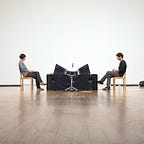Aleatoric elements
In our previous post, we talked about how we created music for Signal Tide — together with David, Drew, James, and several others — recording new versions of specific sacred harp hymns. However, the work that we undertook was not just a process of re-creating new versions of existing songs. We also recorded many further strands of sound, deliberately leaving the borders of this process porous and diffuse. We gave ourselves the task of recording sound that we felt could have a coherent sonic co-existence with the sound created by the signal from the satellite — the one constant consideration.
With this in mind, David, Drew, and James recorded plenty of sound (on guitar, organ, bass, electronics, drums, tapes, and through re-interpreting parts of the existing recordings, along with other sonic researches). We began to refer to this growing pile of experiments as ‘filaments’ — single threads of sound, usually somewhere between three and ten minutes in length, that could be combined with the sound from the satellite, and also overlaid on top of each other in various ways.
There were two main things that we knew about the sound that we would get from the signal of the LES-1 satellite. The first was that it would be a single tone, repeating approximately every four seconds. The second was that each time the satellite passes overhead, this signal would be slightly different, in ways that are not predictable. The height of the pass, the amount of radio interference in the atmosphere, the angle of the satellite as it spins, the position of the sun — all of these factors, and others, would affect the signal, and thus the sound being played.
This unpredictability, which is inherent in the ‘sky’ side of the installation, was an aspect that we wanted to mirror in how the ‘ground’ side of the installation would function — we didn’t simply want to have a single accompanying soundtrack for the satellite, but rather we wanted to allow for an aleatoric, chance-determined process in how the music and sound would be played, so that each pass, and each accompaniment to the pass, would be unique and unrepeatable. As such, we started to think of ways in which the recordings that we had created could be used in this way, and the filaments, these threads of sound, seemed like a good starting point for this process.
Of course, these kinds of ideas around chance and choice-making have a century or so of preceding history — from Duchamp up to the present day. In our initial talks about the work, we had also referred, on a few occasions, to Zaireeka, the 1997 album by the Flaming Lips. This album was released as a set of four compact discs, with the intention that the listener, or listeners, should play all four discs simultaneously, on four CD players. Signal Tide will be working with similar ideas of chance and unpredictability — though, conveniently, you won’t need to buy a shelf full of audio equipment to be able to hear it.
As we figured out these conceptual questions, we also needed to figure out what the practical, material way of making this all happen would be. At Kris’s suggestion, we started to investigate using Substrate, a non-graphical DAW, scriptable in Ruby, created by Will Light and R. Kevin Nelson, which could be programmed to control the speakers in the installation, and allow us to set parameters within which the software would choose which sound to play, and when.
All of this, finally, will be run through the Cymatic Audio LP-16 soundcard, which will allow us to run up to eighteen channels of audio simultaneously.
Now to start setting it all up!
